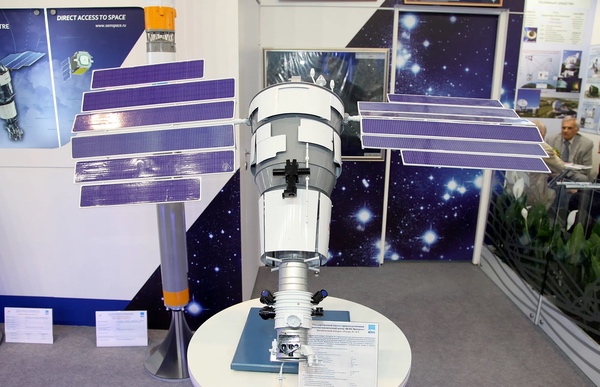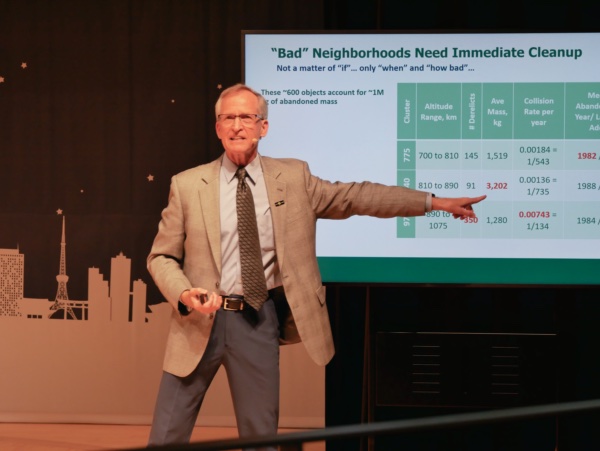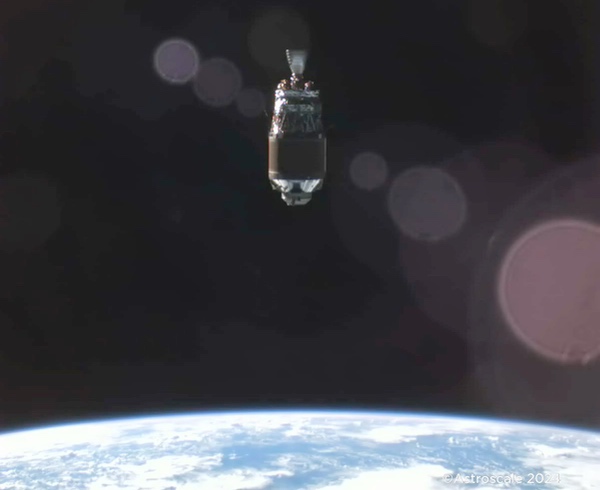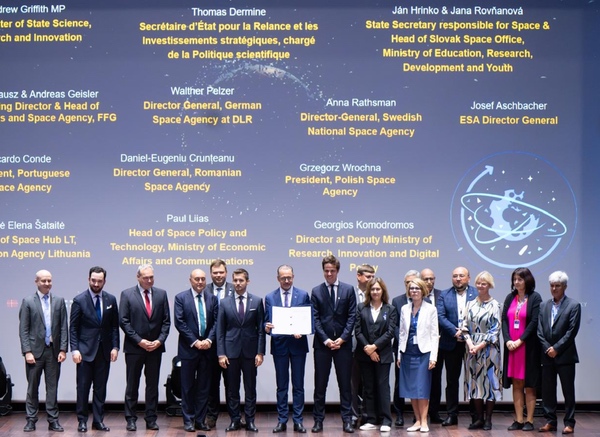
 A model of the Resurs P1 satellite that broke up in low Earth orbit in June. (credit: Vitaly V. Kuzmin CC BY-SA 4.0) |
by Jeff Foust
Monday, July 29, 2024
For a moment, many in the space industry feared the worst. U.S. Space Command reported June 27 that a defunct Russian satellite, Resurs P1, had broken up in low Earth orbit the previous day. One company, LeoLabs, reported that its radars had detected at least 180 pieces of debris from the satellite. The event prompted International Space Station controllers to instruct crews to go into the “safe havens” of their docked spacecraft as a precaution; they were able to return to the station after an hour.
The nature of the event led to some speculation that Resurs P1 was the target of a Russian antisatellite test, similar to Cosmos 1408 in November 2021. However, there were no statements from Russian officials or Western intelligence to indicate that any test had occurred. LeoLabs said a week after the event that, based on its analysis of the tracked debris, that the spacecraft suffered a “low intensity explosion” either from a collision with a small, untracked piece of debris or structural failure of the spacecraft itself.
| “The global space community is running out of time to gracefully transition from the current world of reliable LEO space operations to an environment where mission lifetimes are routinely curtailed due to orbital debris impacts,” McKnight warned. |
“Taking a look at how it broke up, it looks like a pretty typical satellite age-based failure,” said Dana Weigel, NASA ISS program manager, at a briefing Friday about the upcoming Crew-9 mission. NASA took “very conservative actions” in response to the breakup, including ordering the crews to the safe havens. “We pretty quickly got data and realized it wasn’t a big risk or threat for us.”
While Resurs P1 itself appears to have caused little harm, it is a reminder of the growing challenges facing satellite operators in low Earth orbit. An increasing number of satellites, and debris, is in orbit, and both companies and agencies are increasingly sounding the alarm about this growth, with the need for both stricter rules about operations of satellites and efforts to remove some of the most hazardous debris.
 Darren McKnight of LeoLabs discusses the threat posed by debris in clusters in LEO at the Summit for Space Sustainablity. (credit: J. Foust) |
An “apocalyptic” warning
One of those warnings came at the latest Summit for Space Sustainability, the annual conference organized by the Secure World Foundation and held earlier this month in Tokyo. That came in the form of an assessment by Darren McKnight, a senior technical fellow at LeoLabs, which he called “apocalyptic.”
“The global space community is running out of time to gracefully transition from the current world of reliable LEO space operations to an environment where mission lifetimes are routinely curtailed due to orbital debris impacts,” he warned.
That conclusion came from an assessment he did of debris in three clusters in LEO at altitudes of 775, 840, and 975 kilometers. Those clusters include large objects, like upper stages, that in some cases were abandoned in those orbits decades ago.
“We’ve actually been running this experiment since the mid ’70s, mid ’80s,” he said. Each cluster has specific characteristics: the 775-kilometer cluster is the oldest, with a median year of objects being added being 1982. The 840-kilometer cluster has the most massive objects, with an average mass of 3,200 kilograms, while the 975-kilometer cluster has the most large objects, with 350.
McKnight’s assessment concluded that there is a 7% chance of there having been a collision in the 775-kilometer cluster by 2024, 5% at the 840-kilometer cluster, but a whopping 26% chance in the 975-kilometer cluster. By 2039, that probability of a collision at 975 kilometers grows to 34%.
There have been no collisions in those clusters yet, but his assessment shows it is a matter of time if no action is taken. “These are things that are not one in a million, one in a thousand. These are numbers that are measurable with percentage signs,” he concluded.
Any collision between two large objects in those clusters would likely create thousands of pieces of debris large enough to be tracked, posing hazards for anyone trying to operate satellites in or near those orbits. “I’m not saying we’re going to have the Kessler Syndrome,” he said, referring to the runaway growth of debris that could render some orbits unusable, “but we do not have to have the Kessler Syndrome to have a concern that’s going to affect the space economy.”
His presentation was the prelude for a panel at the conference about active debris removal. Several technology demonstration efforts are underway to show how it is possible to remove defunct satellites and upper stages from orbit, including the Commercial Removal of Debris Demonstration (CRD2) effort by the Japanese space agency JAXA. It awarded a contract to Astroscale for one ongoing mission, Active Debris Removal by Astroscale-Japan (ADRAS-J), to inspect the upper stage of an H-2A rocket left in LEO, to be followed by a second mission, also led by Astroscale, to deorbit it.
But the challenges with active debris removal (ADR) remain as much financial and regulatory as they are technical, including who pays for debris removal and how to handle dangerous debris from other countries. “There is no global consensus on who is responsible and what needs to be removed from orbit,” said Aya Iwamoto, vice president of policy and government relations for Astroscale Japan. “This issue can be very tricky and sensitive sometimes, so I don’t see this issue being resolved any time soon.”
| “There is no global consensus on who is responsible and what needs to be removed from orbit,” said Iwamoto. “This issue can be very tricky and sensitive sometimes, so I don’t see this issue being resolved any time soon.” |
Both she and Toru Yamamoto, leader of the CRD2 program at JAXS, also noted the challenge of the business case for ADR despite its importance. Yamamoto said on the panel that he doubted there was a sufficient market for debris removal alone for companies. “I think that the ADR mission should be preferably carried out by private on-orbit servicing companies” that do ADR along with other services, he concluded—the approach Astroscale is taking with other lines of business focused on satellite servicing and life extension.
“National programs are very important to get started,” said Chuck Dickey, former deputy general counsel at Lockheed Martin Space and now principal at Three Country Trusted Broker, on the panel, citing CRD2 and a similar project supported by the UK Space Agency. But, he added, “we really need to figure out a way to cooperate to actually make a significant reduction in overall risk.”
 A Japanese H-2A upper stage as seen in June by Astroscale’s ADRAS-J spacecraft, a precursor to a debris removal mission. (credit: Astroscale) |
ESA’s assessment
This month also saw the release of the annual report on the space environment by ESA. The report noted there are now 35,000 objects in orbit at least ten centimeters across, the usual threshold for tracking. Of those, a little more than 9,000 are active satellites, with the rest being debris.
There has been an “exponential growth” in active satellites in the last few years, said Tim Flohrer of ESA’s space debris office during a panel discussion at the COSPAR Scientific Assembly earlier in the month, just before the release of the report. Debris is also growing, but also (fortunately) not at exponential rates.
The increase in both active satellites and debris is becoming a challenge for satellite operators, he said, particularly in orbits above 500 kilometers as the number of satellites there grows.
“There is a lot of operational burden because handling a close approach with an active object is very much different than handling a close approach with a piece of debris,” Flohrer said, requiring coordination with the other operator. “The highest costs that are not planned in mission operations after the launch is collision avoidance.”
| “The extrapolation of the current changing use of orbits and launch traffic, combined with continued fragmentations and limited post mission disposal success rate could lead to a cascade of collision events over the next centuries,” the ESA report concluded. |
The report does show some signs of improvement in efforts to adhere to orbital debris mitigation guidelines, such as deorbiting spacecraft no more than 25 years after the end of their missions. For example, the fraction of rocket bodies like upper stages that perform a controlled reentry has increased from 10% to 60% in the last decade, the report noted.
Those changes are welcomed, but ESA argues are not sufficient. “Whereas adoption of, and compliance to, space debris mitigation practices at a global level is noted as slowly increasing, it is of importance to note that the successful implementation is still at a too low level to ensure a sustainable environment in the long-run,” the report states (emphasis in original.) Steps like the increase in rocket body reentries, it noted, was linked to launches that are themselves deploying large constellations.
“The extrapolation of the current changing use of orbits and launch traffic, combined with continued fragmentations and limited post mission disposal success rate could lead to a cascade of collision events over the next centuries,” the ESA report concluded. “Based on these findings, among others, there is a growing consensus that stricter space debris mitigation practices need to be implemented globally, and, eventually, remediation might need to be considered.”
 Representatives of a dozen European countries signed the Zero Debris Charter at an event in Brussels in May. (credit: ESA) |
Zero debris (sorta)
ESA has fashioned itself as a leader in space sustainability through its annual report and other measures. That includes spearheading an initiative called the Zero Debris Charter, which calls on signatories to become “debris-neutral” or not leave any debris in orbit by 2030.
In May, ESA announced that 12 countries, all either full ESA members or otherwise associated with it, had signed the charter. That was followed in June by 41 companies and organizations.
“The Zero Debris Charter signals Europe’s unwavering commitment to be a global leader on space debris mitigation and remediation, fostering collective action of a large community of space actors from all around the world,” said Quentin Verspieren, space safety program coordinator at ESA, in a statement.
While ESA is leading the charter, the agency emphasizes that the charter is not ESA’s alone. “This charter is often perceived as an ESA charter, but it is not,” said Holger Krag, head of ESA’s space safety office, at the Summit for Space Sustainability. “It’s a community document established by several players from international organizations, nongovernment organizations, industry, and space agencies.”
He said the charter is designed to push signatories to a greater level of space debris compliance that required by existing national laws. “The charter is in recognition of the situation we are in that the existing laws and guidelines are not sufficiently focused,” he explained. “Being an operator ourselves—ESA is an operator of 28 spacecraft—we know that this is not because of ignorance, it’s because of the fact that it is technically difficult to retire a mission, passivate it, and dispose it safely after five or ten years of operations.”
| The requirements of the charter won’t take effect immediately, Krag said. “We cannot ask for requirements that are not technically fulfillable.” |
The charter itself is a two-page document, but one with technical requirements for signatories to follow, such as requiring that space objects should be removed from orbit at the end of their missions with a 99% probability of success. “It’s in line with space law and international guidelines, but it goes beyond,” he said.
When ESA announced the first set of countries to sign the charter, it raised questions about whether it might conflict with a proposed European Union space law, yet to be introduced after extensive delays. That law is expected to set its own rules about debris mitigation that would apply not just to EU member states but also to companies in other countries seeking to operate in the EU.
“I think it’s not either-or,” said Anna Christmann, German federal aerospace coordinator and ESA ministerial council chair, at a briefing after a joint ESA-EU space council meeting in May. She argued there was a role for an EU space law with space sustainability provisions. “But on the other hand, it’s very important that ESA is active on this going forward with, I think, really outstanding standards for zero debris.”
The charter is not legally binding, “but ESA has decided for itself that we are following the zero-debris approach in which we make these requirements applicable to all our missions,” Krag said, although those requirements will not take effect immediately. “What we are talking about here is technology to be there. We cannot ask for requirements that are not technically fulfillable.”
Notably, the Summit for Space Sustainability took place just days after ESA launched the inaugural Ariane 6. That mission profile included a final burn of the upper stage intended to deorbit it, but a malfunction in the stage’s auxiliary power unit meant that the engine could not relight, stranding it in low Earth orbit.
That is, at the very least, an embarrassment for ESA given its focus on space sustainability and zero debris guidelines. Might it become an opportunity, though, to demonstrate active debris removal technologies like what JAXA is doing with Astroscale with the CRD2 program?
“It is something that we regret,” ESA director general Josef Aschbacher said in an interview last week during the Farnborough International Airshow. He added that, when the upper stage engine failed to restart for that deorbit burn, controllers decided to leave two reentry capsules, which were to deploy after the burn, attached to the stage: “we did not want three debris units in orbit but instead only one.”
ESA has its own project, ClearSpace, to demonstrate the ability to deorbit debris, but that particular spacecraft under development is not designed to handle a large upper stage like the Ariane 6. “We will look into options” for deorbiting the Ariane 6 stage, he said, “but it may be a question of funding, if we can find the extra funding to deorbit it.”
However, it’s clear overall awareness of the growing debris problem is changing. Ray Fielding, head of sustainability and active debris removal at the UK Space Agency, recalled at the Summit for Space Sustainability panel that a young girl at a science fair the agency attended wanted to know why there was space junk. “Well, nobody has been cleaning up. We’ve just been leaving it,” he recalled telling her.
“She said, ‘You are stupid! You are stupid! Why have you done that? Why have you let this happen?’ She was certainly convinced that space sustainability is important.” Hopefully others will be convinced sooner rather than later.
Note: we are now moderating comments. There will be a delay in posting comments and no guarantee that all submitted comments will be posted.






